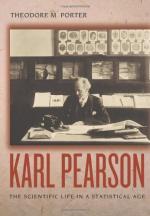|
This section contains 316 words (approx. 2 pages at 300 words per page) |
World of Scientific Discovery on Karl Pearson
The son of a lawyer, Pearson was tutored at home for most of his early life, although between the ages of nine and sixteen he attended the University College School. He began his university studies at King's College, Cambridge, where he graduated third in his class after majoring in mathematics. Following his graduation in 1879 he was awarded a fellowship at the College, giving him the financial freedom to study and travel as he pleased. In 1881 he received a law degree, but he never practiced, choosing instead to pursue studies in mathematics. In 1882 Pearson was awarded his master's degree and became professor of Applied Mathematics and Mechanics at University College in London.
In 1891 Pearson took on the additional job of lecturer in geometry at Gresham College, London, which required that he give a short series of lectures each year. It was from one such lecture that Pearson became interested in developing statistical methods for investigating evolutionary and hereditary theories. Pearson's work in the field of statistics produced many important breakthroughs, particularly his theories of correlation, standard deviation, and, his most significant finding, the chi-square test to determine randomness. Pearson demonstrated how the chi-square test could be applied to determine whether two hereditary characteristics, such as height and hair color, were inherited independently.
Combining mathematics with the sciences of evolution and heredity, Pearson formed the new science of biometrics--statistics as it applies to biological subjects. He submitted many papers on the subject to the Royal Society of London, which led to his appointment as head of the Laboratory of Eugenics at London University in 1906. In 1911 he assumed the post of Galton professor of Eugenics, a position he held until his retirement in 1933. Up until his death in 1936, Pearson dedicated himself to postgraduate student training and eugenic research, examining the importance of environment and heredity in such conditions as tuberculosis and alcoholism as well as infant mortality.
|
This section contains 316 words (approx. 2 pages at 300 words per page) |


